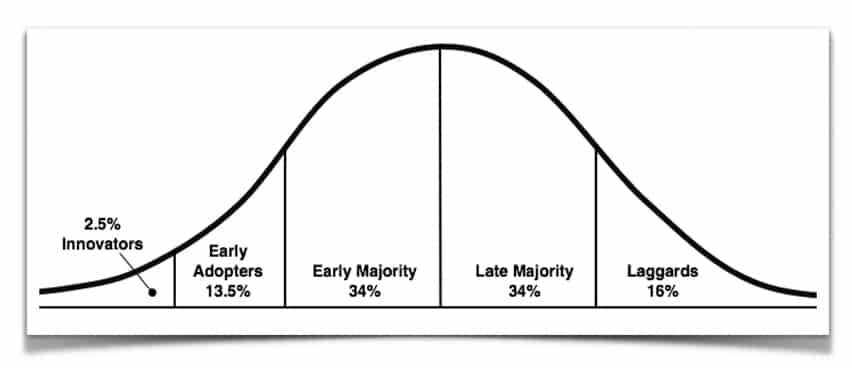Have you identified your Stupid Majority yet?
The story of the prevailing underdog seems to be as old as humanity itself. And the underdog strategy is also impactful in public relations (PR).
As a PR advisor since 2005, I’ve helped many brands side with a Smart Minority in the fight against a Stupid Majority — often with spectacular results.
This blog article will outline how this underdog PR strategy works.
Here we go:
The Stupid Majority PR Strategy
Spin Academy | Online PR Courses
The Stupid Majority
From what conversion theory tells us, minorities tend to hold their opinions more firmly. This is reasonable since going against the majority comes at a higher social cost. 1Silfwer, J. (2017, June 13). Conversion Theory — Disproportionate Minority Influence. Doctor Spin | The PR Blog. https://doctorspin.net/conversion-theory/
But some minorities have an additional advantage:
Smart Minority = a minority of today that will grow into a new majority of tomorrow.
In contrast, some majorities have an additional disadvantage:
Stupid Majority = a majority of today that will steadily decline into a minority of tomorrow.
Examples of Stupid Majorities
Stupid Majorities are to be found everywhere:
“Riding a skateboard isn’t a real sport!”
(Stupid Majority vs Red Bull)
“Computing is about bits and bytes, not design!”
(Stupid Majority vs Apple)
“Websites and apps can’t produce movies and television shows!”
(Stupid Majority vs Netflix)
“Electric cars can’t compete with gas cars!”
(Stupid Majority vs Tesla Motors)
“Hotels must have hotel rooms!”
(Stupid Majority vs AirBnB)
“Taxi companies must have taxis!”
(Stupid Majority vs Uber)
“Media companies must produce media!”
(Stupid Majority vs Facebook)
Identifying a Stupid Majority (and siding with a Smart Minority) will clarify your core message and attract highly engaged minority supporters.
Since time’s by your side (the Stupid Majority will be gone no matter what), targeting a Stupid Majority might become your career’s most influential PR strategy.
Read also: The Stupid Majority PR Strategy: How Underdogs Dominate
💡 Subscribe and get a free ebook on how to get better PR ideas.

The Conversion Theory
Spin Academy | Online PR Courses
The Conversion Theory: The Powerful Minority
The disproportional power of minorities is known as the conversion theory. 2Conversion theory of minority influence. (2021, February 12). In Wikipedia. https://en.wikipedia.org/wiki/Conversion_theory_of_minority_influence
How does it work?
The social cost of holding a different view than the majority is high. This increased cost explains why minorities often hold their opinions more firmly. It takes determination to go against the norm. 3Moscovici, S. (1980). Toward a theory of conversion behaviour. In L. Berkowitz (Ed.), Advances in Experimental Social Psychology, 13, 209 – 239. New York: Academic Press
In contrast, many majority members don’t hold their opinions so firmly. They might belong to the majority for no other reason than that everyone else seems to be. 4Chryssochoou, X. and Volpato, C. (2004). Social Influence and the Power of Minorities: An Analysis of the Communist Manifesto, Social Justice Research, 17, 4, 357 – 388
“In groups, the minority can have a disproportionate effect, converting many ‘majority’ members to their own cause. This is because many majority group members are not strong believers in its cause. They may be simply going along because it seems easier or that there is no real alternative. They may also have become disillusioned with the group purpose, process, or leadership and are seeking a viable alternative.”
Source: Changingminds.org 5Conversion Theory. (2023). Changingminds.org. https://changingminds.org/explanations/theories/conversion_theory.htm
According to conversion theory, while majorities often claim normative social influence, minorities strive for ethical high ground.
Given the power of normative social influence, minorities must stick together in tight-knit in-groups that can verbalise the same message repeatedly.
Learn more: Conversion Theory: The Disproportionate Influence of Minorities
💡 Subscribe and get a free ebook on how to get better PR ideas.

Diffusion of Innovations
Spin Academy | Online PR Courses

Diffusion of Innovations
The Diffusion of Innovations theory, proposed by Everett Rogers in 1962, remains a framework for understanding how new ideas, technologies, products, or practices spread through societies over time. 6Rogers, E. M. (2003). Diffusion of Innovations (5th ed.). Free Press.
The theory outlines the process by which innovations are adopted by individuals and groups, emphasising the role of communication channels, social networks, and the characteristics of the innovation itself.
By examining real-life examples, we can better comprehend the principles of this theory and its applications in various fields:
The Diffusion of Innovations theory offers insights into how new ideas and technologies influence societies. Understanding these dynamics can inform public relations strategies across diverse contexts.
“Diffusion research has helped understand new product adoption and diffusion, with network analysis and field experiments being promising tools in understanding the consumption of new products.”
Source: Journal of Consumer Research 7Rogers, E. (1976). New Product Adoption and Diffusion. Journal of Consumer Research, 2, 290 – 301. https://doi.org/10.1086/208642
Learn more: Diffusion of Innovations
💡 Subscribe and get a free ebook on how to get better PR ideas.

David and Goliath
We know the story:
Goliath, the giant Philistine warrior, was defeated by the young David, who would later become the king of Israel. Being inferior in size and combat experience, David used a slingshot to defeat the mighty Goliath from a distance.
“Giants are not what we think they are. The same qualities that appear to give them strength are often the sources of great weakness.”
— Malcolm Gladwell
Instead of fighting Goliath on his terms (strength and power), David used his advantages (speed and accuracy).
In David and Goliath: Underdogs, Misfits and the Art of Battling Giants, Malcolm Gladwell outlines the dynamic between mapping your and your opponent’s strengths and weaknesses. He goes on to suggest that underdogs have significant advantages:
One could argue that David’s disadvantages (being more negligible and less experienced) forced him to outsmart his opponent.
If David had been an experienced warrior with the physical size to match Goliath’s prowess, David would probably have decided to fight him on equal terms, right?
How We Admire Underdogs
“There is no good or bad without us, there is only perception. There is the event itself and the story we tell ourselves about what it means.”
— Ryan Holiday
The legend of David and Goliath endures as we find comfort in knowing that the strongest doesn’t always win. The underdog approach isn’t just helpful in fighting; it has a proven track record of being highly useful in public relations.
In The Obstacle Is the Way: The Timeless Art of Turning Trials into Triumph, Ryan Holiday describes how choosing the path of the most resistance maximises our growth as both individuals and organisations:
Having the odds stacked against you might not be as bad as it seems at first glance. If nothing else, it’s the start of a great story.
Yes, David exploits Goliath’s weaknesses (not being fast or accurate enough to beat David from a distance). However, David still chooses to fight Goliath on “his” grounds — to steal away “his” audience. It’s safe to say that only a minority thought that David would beat Goliath before the actual fight.
From a PR perspective, David could sweep in from nowhere and beat the market leader by exploiting an interesting social phenomenon … that the majority is sometimes just wrong.
Stupid, even.
We celebrate that David chose a better weapon when we instead should celebrate his successful manipulation of the Stupid Majority; from nowhere, David inserted himself into the top spot — in just one bold move.
We respect David not only for his wits but for his guts.
After all, David did bring a fucking slingshot to a sword fight.
The fact that a staggering majority of bystanders — including one confident Goliath — never expected David to stand a chance, well, that was what gave him the upper hand.
Goliath? He was destined to fail.
Not All Majorities Will Last
When leveraging an underdog public relations strategy to beat a majority leader, it’s not about bringing better weapons; it’s about having guts and taking on a majority that is stupid, incompetent, dead wrong — and more powerful than you.
The more significant and dominant the majority, the more likely it is to consist of a substantial silent majority who are just along for the ride, mainly because everyone else seems to be.
Now, imagine this majority being just plain wrong.
If you can spotlight the majority’s stupidity, some casual supporters might feel betrayed by their majority leaders, causing many such casual supporters to switch sides even faster.
Some majorities of today are destined to be gone tomorrow.
Seeing a minority defeating a majority makes for good entertainment — when the majority is also stupid. And from a PR perspective? The big bad is about to beat the underdog against all the odds. That’s a great story, just begging to be told!
What remains for us is to ask: are there any Stupid Majorities for us to take on?
Challenge a Stupid Majority
Stupid Majorities exist in your industry, too. And now that you know what to look for, you’ll soon start finding them everywhere.
The Stupid Majority approach could result in the most profound results of your public relations career:

Thanks for reading. Please support my blog by sharing articles with other communications and marketing professionals. You might also consider my PR services or speaking engagements.
PR Resource: Free Strategy PR Course

Spin Academy | Online PR Courses
Doctor Spin’s PR School: Free Strategy PR Course
Unlock the power of strategic public relations with this free Strategy PR Course. Elevate your skills and boost your career today.
Public Relations Strategy 101
Public Relations Strategies
Learn more: All Free PR Courses
💡 Subscribe and get a free ebook on how to get better PR ideas.

ANNOTATIONS
| 1 | Silfwer, J. (2017, June 13). Conversion Theory — Disproportionate Minority Influence. Doctor Spin | The PR Blog. https://doctorspin.net/conversion-theory/ |
|---|---|
| 2 | Conversion theory of minority influence. (2021, February 12). In Wikipedia. https://en.wikipedia.org/wiki/Conversion_theory_of_minority_influence |
| 3 | Moscovici, S. (1980). Toward a theory of conversion behaviour. In L. Berkowitz (Ed.), Advances in Experimental Social Psychology, 13, 209 – 239. New York: Academic Press |
| 4 | Chryssochoou, X. and Volpato, C. (2004). Social Influence and the Power of Minorities: An Analysis of the Communist Manifesto, Social Justice Research, 17, 4, 357 – 388 |
| 5 | Conversion Theory. (2023). Changingminds.org. https://changingminds.org/explanations/theories/conversion_theory.htm |
| 6 | Rogers, E. M. (2003). Diffusion of Innovations (5th ed.). Free Press. |
| 7 | Rogers, E. (1976). New Product Adoption and Diffusion. Journal of Consumer Research, 2, 290 – 301. https://doi.org/10.1086/208642 |





